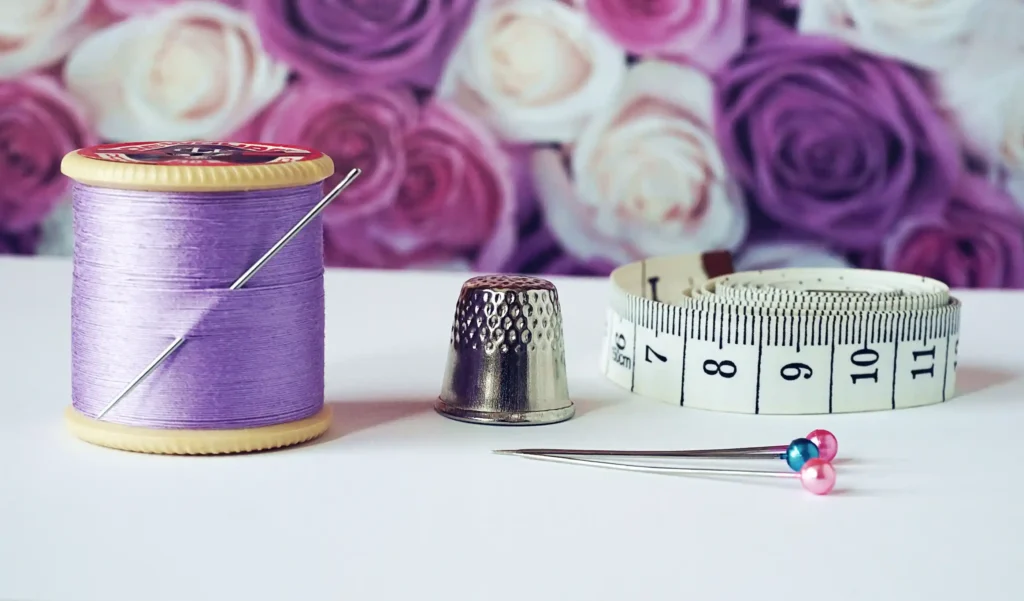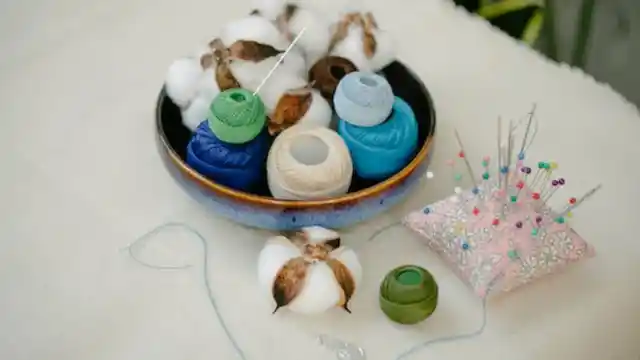Why Does My Needle Keep Unthreading?
Sewing is a fun and rewarding hobby, but it can quickly become frustrating when you experience problems with your sewing machine. One of the most common issues that sewists face is needle unthreading – when the top thread keeps coming out of the needle eye while you’re sewing.
Not only is it annoying to have to stop and rethread the needle constantly, but it can also indicate other issues with your sewing machine that need to be addressed.
In this comprehensive guide, we’ll cover the top reasons your needle keeps unthreading and how to fix them, so you can get back to sewing!
Why Does My Needle Keep Unthreading?
Not Leaving Enough Thread Tails
One of the most common reasons your needle keeps unthreading is not leaving long enough thread tails when you start sewing. The thread tail is the extra amount of thread that hangs below the needle before you begin stitching.
You need to leave a thread tail of at least 4 inches (10cm) when threading your needle. This gives enough slack for the thread to catch in the fabric when the needle punches through and prevents the thread from pulling out of the needle eye.
Leave at least 4 inch thread tails when sewing.
If you’re sewing with knit fabrics, you may need to leave even longer thread tails of 6 inches or more. Knits are stretchy, so they require more thread slack.
You can also try holding the thread tails taut when starting to sew, then letting go after several stitches. Just be careful not to pull too tight, which can cause bunching.
To prevent your needle from unthreading:
- Always leave thread tails of at least 4 inches (10cm)
- Use longer tails of 6+ inches with knits
- Gently hold tails taut for the first few stitches
Take-Up Lever Not in Highest Position
Another common cause of needle unthreading is starting to sew without the take-up lever in the highest position. The take-up lever is the part that pulls the top thread up and down with each stitch.
If the take-up lever is not at its peak when you start sewing, there won’t be enough slack in the thread for it to catch properly in the fabric. The thread will pull out of the needle eye instead.
Make sure the take-up lever is at its highest point before sewing.
To fix this:
- Turn the handwheel towards you until the take-up lever is at its highest point
- Engage the handwheel locking mechanism (if your machine has one) to prevent it turning
- Double check the take-up lever is fully raised before starting to sew
Newer computerized machines will automatically stop in the correct position, but it’s wise to double check if experiencing unthreading issues.
Improper Threading
Believe it or not, threading mistakes are one of the most common causes of sewing machine headaches! Even experienced sewers sometimes thread their machines incorrectly.
If the thread is not following the proper path from spool to needle, it can cause a whole host of problems like skipped stitches, thread jams, and tension issues. Improper threading can definitely lead to your needle unthreading.
To rule this out, it’s best to completely rethread your machine from scratch:
- Raise the take-up lever to its highest position
- Remove and reattach the spool of thread
- Ensure the thread passes through the tension discs
- Follow the thread guides according to your manual
- Pull the thread through the needle eye
- Leave a 4 inch thread tail
It’s easy to accidentally miss a thread guide or two, so tracing the full path is important. Refer to your sewing machine manual for the proper threading diagram.
Thread Tension Problems
The tension settings on your sewing machine control how tight the top thread is pulled through the fabric. Correct thread tension helps form even, straight stitches.
If the tension is too loose or too tight, it can cause all sorts of stitch issues or even lead to the thread pulling out of the needle.
There are two main ways to adjust tension on a sewing machine:
- Tension dial – Rotating this dial increases or decreases the tension. It’s usually numbered between 1-10.
- Presser foot pressure – Higher pressure causes tighter tension. Lower pressure reduces tension.
To troubleshoot tension issues:
- Start with the tension dial set to 5 and presser foot pressure medium
- Sew a test piece of fabric in your chosen thread/needle
- Examine the test stitches – do they look balanced?
- If not, make small adjustments to the tension dial and re-test
Ideally both thread sides should be evenly embedded in the fabric. If the top thread seems loose and is looping on the underside, the tension needs to be tightened. If the bottom thread is pulling to the top or the stitches look knotted, the tension is too tight and needs loosening.

Correct tension results in balanced stitches with even top and bobbin threading.
Getting your thread tension perfect is fiddly but worth it. Correct tension will solve many stitch issues.
Damaged Needle
While it may seem insignificant, a damaged needle can wreak havoc on your sewing! Even tiny issues like small burrs, blunted points, or bent shafts are enough to shred thread or cause maddening problems like skipped stitches and needle unthreading.
Signs your needle may be damaged:
- Needle unthreading
- Thread shredding/breaking
- Skipped stitches
- Needle feels rough when passing through fingers
- Fabrics snagging in needle hole
To fix:
- Remove and inspect needle closely for any defects
- Pass needle shaft through fingers – does it feel perfectly smooth?
- Use needle side to smooth pantyhose – does it snag?
- Replace immediately if any damage found
It’s generally recommended to change your sewing machine needle every 6-8 hours of sewing time. So don’t hesitate to swap out a suspect needle for a fresh new one!
Wrong Needle/Thread Combination
Matching your needle and thread correctly is key for smooth sewing. If the needle/thread combination is incompatible, tension struggles, thread breakage, and needle unthreading can occur.
General guidelines:
- Finer threads = smaller needles
- Heavier threads = larger needles
- Most threads = size 80/12 needle
Things to check:
- Is the thread weight too heavy/light for needle size?
- Is the needle hole too small for thread thickness?
- Is the needle inappropriate for fabric type? (stretch, denim etc)
Consult your machine manual for the recommended needle sizes for different thread weights. Investing in a needle variety pack can be useful when sewing different fabrics.

Use the correct needle for your thread weight and fabric type.
Changing your needle size or type is an easy fix that can prevent further trouble. Don’t force a wrong needle/thread combo!
Lint or Damage in Bobbin Area
While not as common, sometimes accumulated lint or damage in the bobbin case can interfere with the top threading and cause the needle to unthread.
The bobbin basket area is very intricate and lint and small fibers can easily build up. A scratched or damaged bobbin case could also lead to snagging. Burrs on the needle plate hole can shred thread.
To inspect the bobbin area:
- Remove the bobbin case and basket
- Use small lint brush to clean around the feed dogs
- Check for scratches, burrs, holes in bobbin basket/plate
- Replace bobbin case if damaged
- Try a fresh needle plate if hole burred
Proper cleaning and replacing any defective parts should stop bobbin issues impacting the top threading. Be very gentle when cleaning around the bobbin area teeth and feed dogs.
FAQs
Why does my needle keep unthreading at the start of a seam?
If the needle unthreads as soon as you start sewing, it’s likely caused by not leaving long enough thread tails or the take-up lever not being at its highest point before you begin.
What tension should my sewing machine be on?
There’s no universal tension setting that works for all fabrics. A good starting point is around 5, but be prepared to adjust based on testing.
How often should you change a sewing machine needle?
Needles should be changed every 6-8 hours of sewing time. Change immediately if any damage is found.
Why does my thread keep breaking?
Frequent thread breakage is another sign of tension problems or a damaged/improper needle. Refer to those sections for troubleshooting tips.
Why are my stitches knotted and looping?
Knotting and looping on the underside of fabric indicates the top tension is too tight and needs to be loosened.
Why does my needle unthread after sewing a while?
If the needle unthreads after successfully sewing for a period, the likely culprit is a small burr or dull tip on the needle causing the thread to shred.
Final Thoughts
Fixing your needle unthreading issues may take some trial and error, but a little diligence should reveal the cause. Don’t ignore this common sewing machine headache – identify and resolve it so you can get back to creating!
Our comprehensive guide has given you several ways to troubleshoot and tips to ensure smooth sewing. Be sure to also check your owner’s manual for specific info on your machine model. Proper threading, tension, needle choice, and cleaning/replacing damaged parts are key to keeping your top thread securely in its needle home.
Sewing hiccups happen, but thankfully most are quick fixes. With some targeted troubleshooting, you’ll have your thread woes licked and be stitching away in no time.
Happy sewing!
